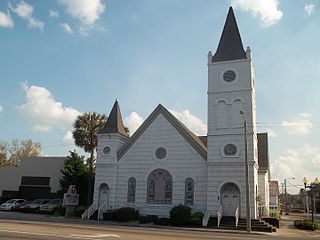
The Christian Church (Disciples of Christ) is a mainline Protestant Christian denomination in the United States and Canada. The denomination started with the Restoration Movement during the Second Great Awakening, first existing during the 19th century as a loose association of churches working toward Christian unity. These slowly formed quasi-denominational structures through missionary societies, regional associations, and an international convention. In 1968, the Disciples of Christ officially adopted a denominational structure. At that time, a group of churches left in order to remain nondenominational.

Community of Christ, known from 1872 to 2001 as the Reorganized Church of Jesus Christ of Latter Day Saints (RLDS), is an American-based international church, and is the second-largest denomination in the Latter Day Saint movement. The church reports approximately 250,000 members in 1,100 congregations in 59 countries. The church traces its origins to Joseph Smith's establishment of the Church of Christ on April 6, 1830. His eldest son, Joseph Smith III, formally accepted leadership of the church on April 6, 1860 in the aftermath of the 1844 death of Joseph Smith.
The Church of the United Brethren in Christ is an evangelical Christian denomination with churches in 17 countries. It is Protestant, with an episcopal structure and Arminian theology, with roots in the Mennonite and German Reformed communities of 18th-century Pennsylvania, as well as close ties to Methodism. It was organized in 1800 by Martin Boehm and Philip William Otterbein and is the first American denomination that was not transplanted from Europe. It emerged from United Brethren churches that were at first unorganized, and not all of which joined this church when it was formally organized in 1800, following a 1789 conference at the Otterbein Church.
The Evangelical Mennonite Conference is a conference of Canadian evangelical Mennonite Christians headquartered in Steinbach, Manitoba, with 62 churches from British Columbia to southern Ontario. It includes people with a wide range of cultural and denominational backgrounds.
The emerging church, sometimes wrongly equated with the "emergent movement" or "emergent conversation", is a Christian movement of the late 20th and early 21st century. Emerging churches can be found around the globe, predominantly in North America, Western Europe, Australia, New Zealand, and Africa. Members come from a number of Christian traditions. Some attend local independent churches or house churches while others worship in traditional Christian denominations. The emerging church favors the use of simple story and narrative. Members of the movement often place a high value on good works or social activism, including missional living. Proponents of the movement believe it transcends labels such as "conservative" and "liberal"; it is sometimes called a "conversation" to emphasize its developing and decentralized nature, its range of standpoints, and commitment to dialogue. Participants seek to live their faith in what they believe to be a "postmodern" society. Disillusionment with the organized and institutional church has led participants to support the deconstruction of modern Christian worship and evangelism, and the nature of modern Christian community.
Transformational Christianity, or Transformationalism, represents a fusion of evangelicalism, Pentecostalism, and ecumenism that started becoming prominent in the early 21st century. Unlike previous movements, it is typically embodied in regional meta-church organizations—alliances of churches from different denominational backgrounds—rather than particular churches, denominations, or parachurch organizations. Critics of Transformationalism accuse it of overemphasizing eschatology, false dichotomies, unnecessary idealism and a tendency to be corrosive of individual church identities.
Church planting is a term referring to the process that results in a new local Christian congregation being established. It should be distinguished from church development, where a new service, worship center or fresh expression is created that is integrated into an already established congregation. For a local church to be planted, it must eventually have a separate life of its own and be able to function without its parent body, even if it continues to stay in relationship denominationally or through being part of a network.

The cell group is a form of church organization that is used in many Christian churches. Cell groups are generally intended to teach the Bible and personalize Christian fellowship. They are always used in cell churches, but also occur in parachurch organizations and other interdenominational settings, where they are usually referred to as Bible study groups. In Methodism, they are known as class meetings and are a means of grace; in Catholicism, they are known as basic ecclesial communities.

The Black church is the faith and body of Christian denominations and congregations in the United States that predominantly minister to, and are also led by African Americans, as well as these churches' collective traditions and members.
Missional living is a Christian practice to adopt the thinking, behaviors, and practices of a missionary in everyday life, in order to engage others with the gospel message.
Great Commission Association of Churches (GCC) is a fellowship of independent evangelical Christian churches. The Great Commission church movement began in the United States in 1970. Other associated organizations include Great Commission Ministries (GCM), Great Commission Latin America (GCLA), and Great Commission Europe (GCE). The movement has grown in size and scope through its focus on church planting in the United States and abroad. GCC is a member of the National Association of Evangelicals, and one or more organizations within the movement has continuously been a part of the Evangelical Council for Financial Accountability since 1992.
The Praise Chapel Christian Fellowship is a church multiplication movement, centered in Los Angeles, California. Praise Chapel is an international family of churches and ministries, and as of February 26, 2019, Praise Chapel has grown to over 300 churches in the United States and over 4300 internationally.

The Methodist Church of Southern Africa (MCSA) is a large Wesleyan Methodist denomination, with local churches across South Africa, Namibia, Botswana, Lesotho and Eswatini, and a more limited presence in Mozambique. It is a member church of the World Methodist Council.
The Word of God is an ecumenical, charismatic, missionary Christian community in Ann Arbor, Michigan. The community began in 1967.
West Bromwich Network Church is a new Christian church that was planted in January 2007 by Rev. Evan Cockshaw, working on behalf of the Church of England's Lichfield Diocese, in partnership with West Bromwich & District YMCA and the Walter Stanley Trust. The role of West Bromwich Network Church (WBNC) is to create new forms of church for the 20-30s generation across the deanery of West Bromwich. It has no pre-defined criteria, other than to reach out to a generation unconnected to Christian faith.
Aglow International is an interdenominational organization of Christian people. It is based in Seattle and Washington, US and has more than 200,000 members.

Dwell Community Church, formerly Xenos Christian Fellowship, is a non-traditional, non-denominational, institutional cell church system. Unlike traditional churches, Dwell is centered on home church activities rather than traditional Sunday morning services. These small groups typically contain 15 to 60 members. Dwell also holds weekly multi-house church gatherings called central teachings. As of February 2009, Dwell has approximately 5,000 members and 300 home churches.

The Church of the Saviour in Washington, DC is a network of nine independent, ecumenical Christian faith communities and over 40 ministries that have grown out of the original Church of the Saviour community founded in the mid-1940s. The current ministries and faith communities are the result of an alternative approach to “church” and church structures which is the hallmark of the Church of the Saviour. This approach and these structures were formed in an effort to improve Christian discipleship and “recover... something of the vitality and life, vigor and power of the early Christian community." In that effort the church's approach emphasizes integrity of membership, the ministry of the laity, and communal intimacy and accountability. This desire for intimacy and accountability among members of the church is what led the community to break into smaller congregations rather than try to grow larger as a single church. It has also led to the formation of small groups called “mission groups”, made up of 2 to 15 members gathered around a shared sense of vocation or God's calling. These groups became the fundamental unit of community and accountability in the church, and the various groups, each following their own sense of call, gave rise to most of the ministries associated with the church. As a structure, the mission groups have been continued in one form or another in the church's offspring faith communities. Through the writings of longtime church member Elizabeth O'Connor (1928–1998) and others, Church of the Saviour has become influential among Christian religious groups throughout the country and has informed such contemporary movements as the missional church movement, the Emergent Church movement, and the New Monasticism movement.
Mike Breen was an English church leader, minister and author, now based in the USA. Breen has led missional churches in Europe and the United States.

Hugh James Osgood is a British church leader, author, and director. He was appointed Moderator of the Free Churches Group on 17 September 2014, following the resignation of Michael Heaney, and was the first President to serve for successive terms. He was also the Free Churches President of Churches Together in England, and is the co-convenor of the UK Charismatic and Pentecostal Leaders’ Conference, and founding President of Churches in Communities International. He is largely known for his work on racial justice, social cohesion and supporting African Christianity in the United Kingdom.







